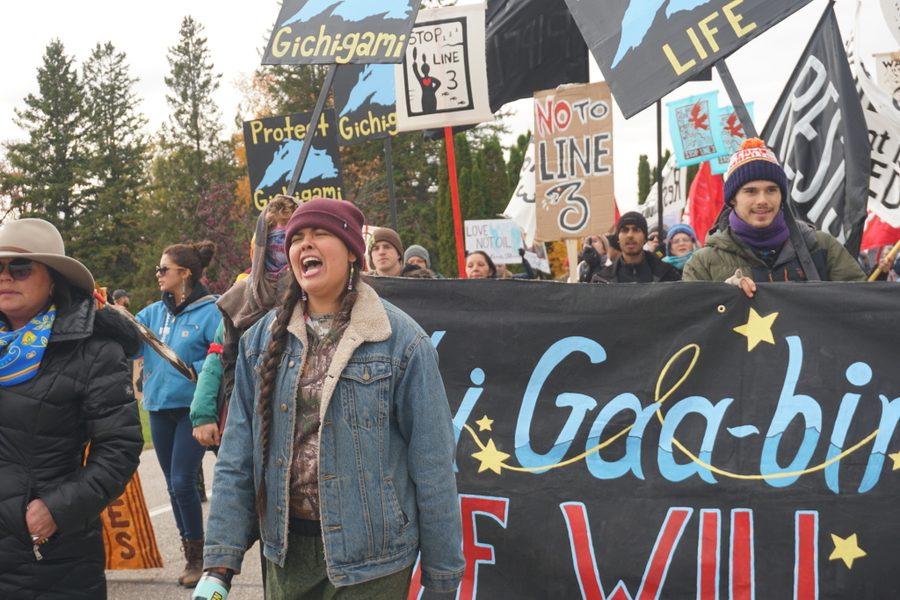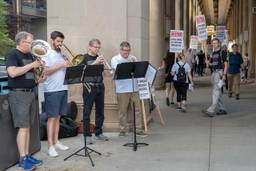On Indigenous People’s Day, Anishinaabeg Leaders March Against Enbridge’s $7.5 Billion Oil Pipeline
The pipeline’s route would carry 760,000 barrels of oil per day, crossing 15 watersheds affecting 215 lakes, and violating Ojibwe treaty rights.
Amelia Diehl

CLEARBROOK, MINN. — On October 14, Indigenous Peoples’ Day, more than 200 Indigenous leaders and allies marched down a highway to Enbridge Inc.’s U.S. pipeline terminal in Northern Minnesota, to protest the proposed Line 3 oil pipeline replacement project.
Braving cold temperatures and a foul stench in the air from the oil terminal, supporters from across the state and region held up signs with messages such as “Water is Life,” “Protect the Sacred” and “Honor the Treaties,” and chanted “Stop Line 3!” As they marched toward the terminal, a large, loud tractor with a “Minnesota for Line 3” sign drove ahead of the group, trying — unsuccessfully — to drown out the chants.
Protesters arranged themselves in a circle outside of the terminal entry gates as Anishinaabeg speakers demanded treaty rights be respected, water sources protected and climate disaster averted. Behind them, large white cylinders, holding tanks containing tar sands oil jutted from the cornfields.
The proposed Line 3 pipeline’s route would carry 760,000 barrels of oil per day from the Alberta tar sands to the western edge of Lake Superior, crossing several sensitive ecosystems, 15 watersheds affecting 215 lakes, and several critical cultural resources, and violating 1854 and 1855 Ojibwe treaty rights along the way. These treaties entitle Ojibwe tribal members to “make a modest living from the land,” even on ceded territory (off-reservation). These rights to hunt, fish, gather medicinal plants, harvest and cultivate wild rice, and preserve sacred or culturally significant sites, would all be threatened by the pipeline. White Earth, Fond du Lac, Red Lake, Leech Lake and Mille Lacs tribes have all engaged in legal processes in an attempt to stop the pipeline.
“Something like Line 3 has the potential to wipe out the culture of my people, the Anishinaabeg people,” says Tara Houska, founder of Ginew Collective, one of the main groups involved in organizing the march on Enbridge.
Houska also notes the potential for an oil spill that could devastate the area. Enbridge has built several oil pipelines in the Great Lakes region, nearly all of which have leaked. Southeast Michigan is still recovering from a one-million-gallon oil spill into the Kalamazoo river in 2010, and the aging Line 5 pipeline, feared to leak into the sensitive Straits of Mackinac between Lake Huron and Lake Michigan, has faced mounting opposition as its infrastructure continues to deteriorate.
“A potential spill … could impact millions of people,” Houska says. “It’s also the overall global climate that’s at stake.”
Costing $7.5 billion, Enbridge’s Line 3 pipeline would be one of the largest crude oil pipelines on the continent. Tar sands oil is the dirtiest form of fuel, 20% more carbon intensive than conventional crude oil. The project’s 2017 Environmental Impact Statement (EIS), written by the Minnesota Department of Commerce, estimated that the emissions associated with a new Line 3 pipeline would have a “social cost” amounting to $287 billion over the first 30 years of the pipeline’s life.
Pipeline construction also poses dangerous risks to Indigenous women and children. Research has documented an increase in drug and sex trafficking and violent crime corresponding to the influx of temporary housing facilities built to accommodate the predominantly male construction workers, known as “man camps.” These camps, which often exacerbate substance abuse problems in stressful working conditions, are one of the many causes contributing to the epidemic of missing and murdered Indigenous women. One 2008 report by researchers at the University of Delaware and the University of North Carolina, Wilmington found that rates of murder against American Indian and Alaska Native women on tribal lands can be up to 10 times higher than the national average.
With so much at stake, Indigenous groups and allies are fighting the project on multiple fronts. Enbridge had originally planned to start operation by the end of this year, but the project faces multiple lawsuits, and will need to secure several key permits from both state and federal agencies. Although the Minnesota Public Utilities Commission unanimously voted to approve the project in 2018, the Minnesota Court of Appeals overturned the project’s environmental review (EIS) this year in response to a lawsuit by project opponents, saying it did not address the risks of a spill in the Lake Superior watershed.
The Minnesota Pollution Control Agency recently denied a key water permit on September 27, noting the invalid EIS. Enbridge will need to provide more information about how negative effects can be mitigated before it can reapply again.
Enbridge began “pre-construction” activities, including surveying, land acquisition, engineering and design in 2014, and the company intends to see the pipeline in full operation in the second half of 2020. Even if Enbridge moves ahead with construction activities that violate their current permits, it may only receive a fine, Houska says.
Still, supporters are confident the resistance will grow.
“The future depends on us winning,” says Mysti Babineau, an Anishinaabe woman with the climate group MN350, who helped organize the march in Clearbrook. “And we will, together.”







